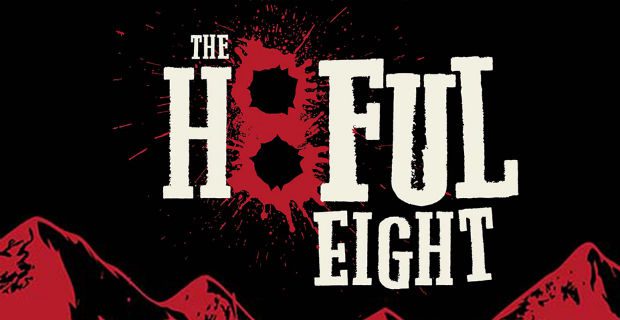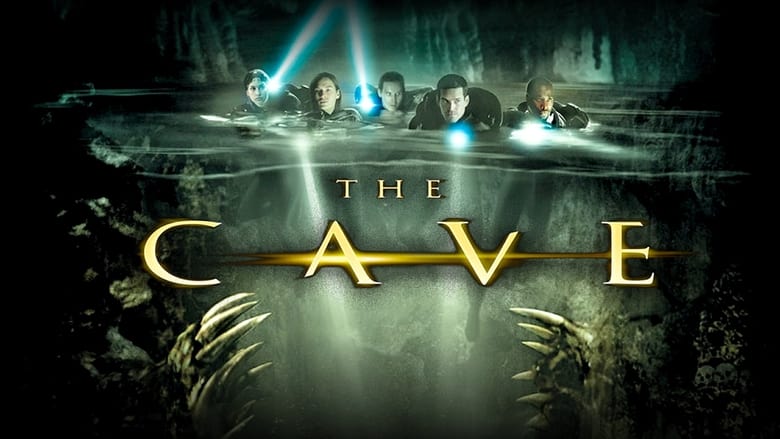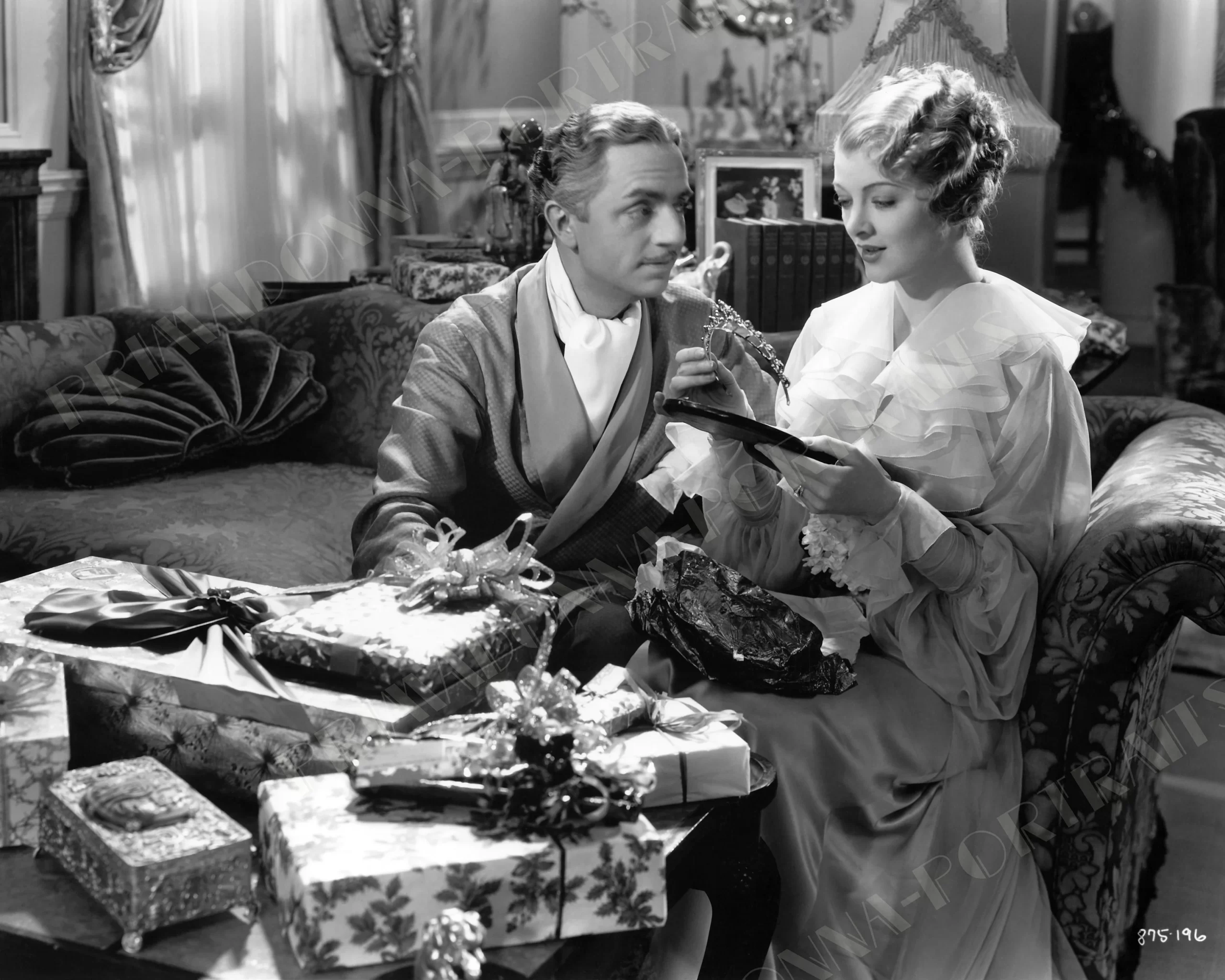Does Tarantino expose the vile undercurrent of racism in America—or does he exploit it? The Hateful Eight, touted in stereotypically pompous fashion even in the opening credits as “the 8th film” by the director again raises the question. What does shine through with more clarity than any of the purported truths in his racial ruminations is the pungent nastiness. From top to bottom this in all the technical senses a gem. But the most gorgeous Tarantino entry yet also turns out to be the ugliest and in a way, the emptiest.
Following a grandly audacious opening with an overture and a cryptic shot of a wooden Jesus, Major Marquis Warren (Samuel L. Jackson), a bounty hunter, emerges from the sea of powdery white in a Wyoming blizzard with three bodies. It’s his good fortune that he happens to cross paths with John Ruth’s stage coach, (Kurt Russell) another bounty hunter who-unlike Warren-believes in taking prisoners alive. His cargo is a dangerous criminal named Daisy Domergue (she’s played by Jennifer Jason Leigh). They’re headed to Red Rock where Warren will collect the money on the corpses he’s transporting and Ruth will turn this woman over to the hangman. Along the way they encounter Chris Mannix, a man on the brink of freezing who claims he will soon be the town’s new sheriff (Walton Goggins). He tells them that if they leave an officer of the law behind to die they’ll be guilty of murder—then proceeds to spend the ride hurling accusations at Warren for his war record as a Union soldier.
The freak weather forces them to take a detour to a local haberdashery where the owner Minnie is conspicuously gone. In her place are a peculiar bunch: Bob the Mexican who claims to be running the store in her absence, the town of Red Rock’s hangman (Tim Roth), a cattle driver who prefers writing to socializing (Michael Madsen) and an aging former Confederate general. Tensions in the room quickly force them to divide the quarters between North and South (one’s dubbed Philadelphia, the other Georgia) but still it doesn’t feel like that much is happening for lengthy stretches of the first half beyond John Ruth’s profound distrust of everyone else. Then, suddenly, one of them is shot and another tries to poison the coffee and Tarantino’s nutty 12 minute intermission arrives leaving you if not riveted, then at least quite curious to know what’s going on.

Every Tarantino movie that’s come before has been in essence a live action cartoon with two crucial exceptions: Reservoir Dogs and Jackie Brown. The former because the moral queasiness and tragedy punctured through the heart of his glib, fast-moving pop culture dialogue; the latter because adapting Elmore Leonard’s Rum Punch forced him out of his zone and into some of the most adult emotions of his career (it’s no surprise that there are more than a few who wish Tarantino had continued on the path set down by Jackie Brown). With The Hateful Eight it feels like he is-whether consciously or not-working in a more serious or at least, less intentionally cartoony vein. Set probably ten or fifteen years after Django Unchained took place, it has a noticeably different feel from either that or the other revenge period-picture that preceded it, Inglorious Basterds partly because of how he doesn’t use any modern music as out of place as say, 2Pac or David Bowie’s “Cat People”. This doesn’t transpire in a comic book world or Tarantino alternate-dimension—which isn’t to say that it feels hyper-realistic either.
The cast is as A-list as any he’s had. Michael Madsen underwhelms by virtue of barely being written a part, and so does Demián Bichir in one of the most flavorless Tarantino roles ever as Bob. Tim Roth is fine (he’s invariably an actor worth watching) but his entire gentlemanly demeanor feels a little like knock-off Christoph Waltz (in fairness, even Waltz himself seems like a Waltz imitator recently in Spectre). Bruce Dern fares better in an already underrated performance. His cold, loathing stare and equally disdainful delivery makes him completely believable as an aging Confederate still dedicated to the cause of slavery and white supremacy.
On the brighter side, Kurt Russell-no stranger to the genre-appears to be channelling John Wayne (at one point even saying “That’ll be the day” just like the late actor so memorably did in The Searchers). It’s a wonderfully charismatic performance every bit as strong as his turn in Death Proof. Jennifer Jason Leigh makes the most of a demented part as a shamelessly, unrepentantly awful person who is treated in kind for all of her sins. She’s definitely worthy of the accolades she’ll receive—even if her less flashy and wholly different turn in Charlie Kaufman’s Anomalisa is in many ways more impressive. Walton Goggins, famous for TV parts on The Shield and Justified, is exceptional and threatens at times to steal the entire show.

Samuel L. Jackson is fantastic in a part that was written specifically for him. Even where the writing drags along, the ideas seem to be drying up, or the energy dips, his righteously comedic and magnetic performance chases your attention back to the movie every time he’s onscreen (there are just a few too many minutes pre-intermission that find him in the background, away from the action entirely). Many of the laughs come not necessarily from Tarantino’s dialogue but from Jackson’s spirited and irreverent delivery.
Of that dialogue much has been made of the gratuitous usage, yet again, of the n-word. Given the understandably polarizing reaction to its ubiquitousness in Django you may think that Tarantino would have shied away from using it again here. Not so. Tarantino had ditched the epithet for a stretch of his career (Kill Bill, Death Proof, and Inglorious Basterds all somehow managed to make do without it). By one count In Hateful Eight it’s said some 65 times. Whereas the epithet’s constant presence in Django felt like it at least made more sense in context here it’s more dubious. When the slur is first used by Jennifer Jason Leigh’s character one gets the feeling that he’s throwing it in percussively-and cynically-for effect as much as historical accuracy. Suffice to say a white critic has no place defending or mansplaining the word and whether uttered one time or one hundred times it’s profoundly ugly like few other words in the English language are. Tarantino, a veritable master of language, obviously can’t plead ignorance on this. It makes the stream of n-word uses seem reckless and careless (not for nothing that critic Armond White accused the movie of “hateful macro-aggressions”). The few moments where Jackson gets to fire back rhetorically with “white man” or “hillbilly” it’s clear that Tarantino is getting off on that. But not being racist in intent isn’t the same thing as exercising sensitivity or good judgement.
On a sensory level at least, Tarantino has made his most beautiful picture. The much-discussed 70 MM really is spectacular: this is the most painterly his shots have ever been (credit cinematography genius Robert Richardson). Even in the confines of what is largely a cramped, one-set whodunnit he consistently finds compelling and dynamic ways to tell the story. The sinister and ominous score by the legendary composer Ennio Morricone sounds evil enough to be its own character. And it’s all in the service of the most rotten and nasty moviemaking of his career.
The violence isn’t simply grim, it’s gleeful. Watching the sole female cast member get punched and beaten around isn’t inherently misogynistic, but the way that it’s arguably played for laughs surely is. The delighted way some in the audience reacted when I saw it made it even worse. Tarantino has made movies with higher body counts and more stylized violence, sure, but the eagerly unflinching and sadistic way he depicts it here is tasteless. He relishes in showing violence more graphic than any he put in the more straightforward movies of his earlier career. In Pulp Fiction poor Marvin’s head is accidentally blown off, but we see only the bloody aftermath. Here a head is similarly shot off and he shows the skull pop like a grape, which is apparently supposed to be amusing.

Tarantino is as giddy as ever about his work. He evens intrudes on his own project with an unnecessary narration that pops up out of nowhere and takes you out of the moment (for reasons I didn’t understand what he says couldn’t have waited for the DVD commentary track). He doesn’t want you or anyone else to forget that he’s solely in charge. Fat chance of that. All it does is remind you how much he needs collaboration and someone to rein in some of his long-winded impulses.
The Hateful Eight starts off strong only to feel increasingly like a minor movie. When the truth’s revealed (which is basically guessed earlier on by a character), it becomes less intriguing, not more. The ending is the worst of his career-its punchline falling flat as a pancake-and as it drags itself along to it the paucity of his vision is glaring. This is a three hour film that just didn’t need to be so and a Reservoir Dogs style flashback finds him coming across like self-parody (it boasts some of his most slapdash anachronistic dialogue). Tarantino’s playing with fire here. He toys around with a couple potentially interesting ideas on race only to supply an outcome that makes all of it feel completely meaningless and cheap. The Hateful Eight is no failure and a couple of the scenes do more than just showcase terrific actors excelling. But it could be so much more. Tarantino has commendably voiced his opposition to brutality by law enforcement and incurred the wrath of the police unions in return. Cinematically speaking, however, he needs to find a greater cause.




